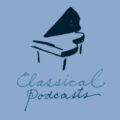Jun 25, 2024
Five Minutes That Will Make You Love…

Five Minutes That Will Make You Love Symphonies is the title of a July 7, 2021 article in The New York Times. This series of stories, appearing regularly in The Times, all begin with the title “Five Minutes That Will Make You Love …” this genre of music – or that instrument – or this composer.
I agree that “Five Minutes” – give or take a minute – is an ideal quantity of music to use to help people learn to enjoy listening to classical music … especially in light of the divergent scientific opinions there are on the average length of the human attention span. Interestingly, some camps say that our average attention span is 8.25 minutes. Others say it is only 8.25 seconds! And there are yet additional studies which posit that we have the capacity to remain focused for an entire 20 minutes! Whoa! Not sure where this revelation leaves the composers of the 19th and 20th centuries who were wont to write orchestral symphonies lasting thirty, forty minutes … or more!
I realize that The Times is not saying that the Five Minutes series will in fact turn a classical music indifferent person into a passionate classical music lover in just five minutes. These features are part of the genre of published opinion known as “listicles” … articles consisting of a series of items presented as a list. Famous actors, musicians along with music critics and writers of stature are asked to offer their favorite few minutes of ___ (fill the blank), which they would play for “their friends” in hopes of igniting love.
For those of us already “on the team,” these lists can indeed enlighten us. We might well discover some piece of classical music not previously on our radar screen. I also assume – perhaps incorrectly – that most of the people who take the time to read these listicles in The Times already “love” classical music. But, at The Discovery Orchestra, we’ve learned that it takes a little bit more time – not a whole lot more time – to help people to experience the “aha’s” needed to notice the various aspects of a classical music selection. Might a person be willing to give this process thirty minutes or even an hour?
In that time frame, a four- to-five-minute movement of classical music can usually be played two times straight through – once at the beginning and once at the end. And in the remaining twenty to fifty minutes, we are not only able to help a person have an “aha” around the important difference between listening and hearing, but also help them to discover for themselves some of the interesting aspects of this music in terms of its elements: the rhythms, melodies, textures, harmonies, dynamics, timbres and forms … or the RMTH-DTF’s as I like to call them … to be enjoyed! Throw in a listening guide to help you visualize this process accompanied by a dash of humor and …voila!
People from around the world who have watched one or more of our videos write us:
“Loved this – a wonderful way to listen to and experience the Infernal Dance from The Firebird. More please!” RR, London, Great Britain
Amazing – I never cared for classical music before tonight. I’m looking forward to Part II next week!” SH, Vancouver City, USA
“I was born in a rural region of South America. I heard classical music on the radio, but I never understood anything. This show brought clarity and an understanding of the music which I really appreciate.” BP, St. Thomas, Virgin Islands
“Just watched your Discovery Concert on Bach on my local PBS channel here in the Bay Area. Thank you! My entire life I have felt that something rich and spiritual must be involved in the music of composers like Bach, but no one ever explained it. Your music director, like the gracious host of a great feast, politely opened the door–and in spite of my ignorance–invited me to dine. He taught my ears and mind to meditate on the bounty. I was moved to tears during his explanation and while the orchestra played their excerpts. Once again thank you for enriching my understanding.” JFO, San Francisco, USA
Again, we must be grateful for The New York Times, which as one of the major daily newspapers of our country, continues to publish not only reviews of the many classical music concerts that take place in New York every week, but also publishes listicles like the one referenced above. Please visit this link.
You may just discover a wonderful classical music work that is new to you!








